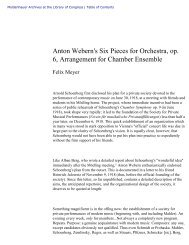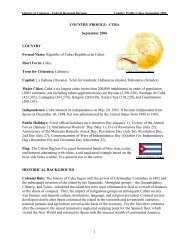1 - American Memory
1 - American Memory
1 - American Memory
Create successful ePaper yourself
Turn your PDF publications into a flip-book with our unique Google optimized e-Paper software.
215<br />
In response to the question, "What would your Inventory be If you were guar-<br />
anteed no shipping interruptions longer than ten days?" those answering affirm-<br />
atively said they could reduce physical inventories as follows:<br />
[In percent]<br />
Share ofjh-nu<br />
Potential reduction in Inventory by days: retponding a/Hrmativeiv<br />
10 to 19 12<br />
20 to 30 57<br />
31 to 65 31<br />
Total (70 percent of total respondents) 100<br />
The corresponding dollar value of potential inventory reductions is as follows:<br />
[In percent]<br />
Firmi<br />
Potential reduction in inventory valuation : rtsponding afflrmativety<br />
10 to 19 18<br />
20 to 40 81<br />
41 to 60 6<br />
Total 100<br />
The cost of carrying extra inventory consists primarily of Interest and ware-<br />
housing expenses. The aggregate total of the cost of carrying extra inventory by<br />
the respondents was $2.8 million, representing 0.9 percent of their gross sales<br />
volume of $300 million in 1973.<br />
Wliolesale Arms estimated their costs of carrying extra inventory at an average<br />
1.5 i)ercent of sales, while retail firms averaged an estimated 0.5 percent of<br />
sales.<br />
To obtain an Industry-vride estimate of the Impact of extra inventory, these<br />
factors were applied to total sales. In the case of wholesale sales in Hawaii for<br />
1973, the total was $2.04 billion. By applying the percentage of 1.5 jwrcent to<br />
this total, we estimate that wholesale firms may have spent about $30 million<br />
to manage the extra Inventory they carry. Similarly, total retail sales for 1973<br />
were $2.74 billion. By applying the extra cost of 0.5 percent to that total, we find<br />
that retail firms may have spent about $14 million in extra inventory costs.<br />
Therefore, on this basis the total costs to wholesale and retail firms in Hawaii<br />
for maintaining "Insurance" inventory were estimated to be approximately $44.3<br />
million in 1973. This averages $200 per household in Hawaii.<br />
Hawaiian business firms viewed the period between July, 1971 and December,<br />
1972 with apprehension. During that 17 month period, three different striltes shut<br />
off incoming and outgoing sea cargo for a total of 5% months. Businessmen saw<br />
their marlcet penetration and sales drop. Consumers were faced with rising<br />
prices as product availability and variety diminished. A guarantee of no shipping<br />
interruptions would offer the following benefits:<br />
1. A number of small firms were forced to discontinue business as a conse-<br />
quence of their inability to obtain delivery of their products, while incurring<br />
substantial debts In the process. Because Mainland manufacturers often bill<br />
their island business customers ten days after a shipment leaves the factory, a<br />
shipping interruption would devastate a small merchant whose cargo Is along-<br />
side or aboard a stalled vessel. A guarantee of no shipping interruptions longer<br />
than ten days would give a business time to divert any cargo to air transport<br />
while allowing ship-carried merchandise to be delivered as scheduled, thereby<br />
avoiding a crippling drain on cash flow.<br />
2. When basic products are in short supply (e.g. paper or steel), firms attempt<br />
on a nationwide basis to stockpile in order to prevent plant shutdowns caused<br />
by backordered materials. The cost to Hawaiian firms of handling additional<br />
shortage-based inventory becomes prohibitive. An assurance that goods could<br />
travel freely by sea could cut these inventories substantially, thereby passing on<br />
a reduction of cost to consumer.<br />
The cost of carrying extra inventory per dollar of sales of those affected range<br />
from 0.4^ to 2.9^. This expense is passed on to all consumers In Hawaii, regard-<br />
less of occupation. The psychology of shortages turns the Hawaiian consumer



![Albert Einstein Papers [finding aid]. Library of Congress. [PDF ...](https://img.yumpu.com/21604228/1/190x245/albert-einstein-papers-finding-aid-library-of-congress-pdf-.jpg?quality=85)





![American Colony in Jerusalem Collection [finding aid]. Library of ...](https://img.yumpu.com/17941275/1/190x245/american-colony-in-jerusalem-collection-finding-aid-library-of-.jpg?quality=85)



![Piccard Family Papers [finding aid]. - American Memory - Library of ...](https://img.yumpu.com/17941234/1/190x245/piccard-family-papers-finding-aid-american-memory-library-of-.jpg?quality=85)


